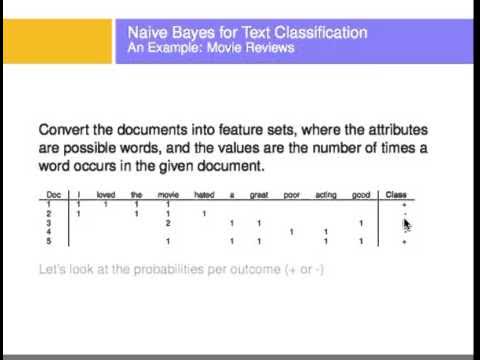SKLearn 13 | Naive Bayes Classification | Belajar Machine Learning Dasar
Summary
TLDRThis video tutorial provides an introduction to machine learning classification using the Naive Bayes algorithm. It covers the process of splitting data into training and test sets, training the Gaussian Naive Bayes model, and making predictions. The video demonstrates how to calculate accuracy using the `accuracy_score` function and the model's `score()` method, achieving an accuracy of approximately 92.9%. The tutorial is designed to help viewers understand basic machine learning concepts and apply them to real-world datasets, with an emphasis on continuous learning and engagement.
Takeaways
- 😀 The script explains how to split the dataset into training (80%) and testing (20%) using the `train_test_split` function from scikit-learn.
- 😀 The dataset is first divided into input features (X) and target labels (Y).
- 😀 The Naive Bayes classifier is applied for classification on a breast cancer dataset using the Gaussian Naive Bayes model.
- 😀 The script uses the `GaussianNB` model from scikit-learn, which is appropriate for continuous data with a Gaussian distribution.
- 😀 After training the model with `X_train`, predictions are made on the test data (`X_test`).
- 😀 Accuracy is calculated using two methods: `accuracy_score` from scikit-learn and the `model.score()` function for simplicity.
- 😀 The accuracy value is displayed, and it is noted that the model achieved an accuracy of around 92.9%.
- 😀 The video demonstrates how to visualize the results with a dataset that includes 455 instances for training and 114 for testing.
- 😀 The script emphasizes the importance of model evaluation and understanding accuracy as a performance metric in classification tasks.
- 😀 The presenter encourages viewers to continue learning and follow the channel for more educational content, with a focus on machine learning techniques.
Q & A
What is the purpose of splitting the dataset into training and testing sets?
-The dataset is split into training (80%) and testing (20%) sets to ensure that the model is trained on one portion of the data and tested on another, helping evaluate its performance on unseen data.
What function is used to split the dataset, and what does it return?
-The function used to split the dataset is `train_test_split()`. It returns four variables: `X_train`, `X_test`, `y_train`, and `y_test`, which represent the features and labels of the training and testing data.
What is the purpose of setting the random_state parameter to 0 in train_test_split()?
-Setting the `random_state` parameter to 0 ensures that the data splitting is reproducible, meaning the same split will occur every time the code is run.
What does the Gaussian Naive Bayes (NB) model do in this context?
-The Gaussian Naive Bayes model is used for classification, which assumes that the features follow a normal distribution and uses Bayes' theorem to predict the class of the data.
How is the Naive Bayes model trained in the script?
-The model is trained using the `fit()` method, where the model learns from the training data (`X_train` and `y_train`).
What function is used to evaluate the model's accuracy, and how does it work?
-The accuracy of the model is evaluated using the `accuracy_score()` function, which compares the predicted results (`y_pred`) with the actual test labels (`y_test`) and calculates the proportion of correct predictions.
What is the difference between using `model.score(X_test, y_test)` and `accuracy_score()`?
-Both `model.score(X_test, y_test)` and `accuracy_score()` evaluate the model's accuracy, but `model.score()` is a simpler, built-in method that returns the accuracy directly, while `accuracy_score()` provides more flexibility by allowing additional metrics.
What was the model's accuracy in the demonstration?
-The model's accuracy was approximately 92.9% based on the testing data.
Why does the speaker recommend using the `model.score()` method?
-The speaker recommends using `model.score()` for its simplicity, as it directly returns the accuracy without the need for additional functions.
How does the script help in understanding machine learning concepts?
-The script provides a practical demonstration of how to apply the Naive Bayes classification model, split data, train the model, make predictions, and evaluate accuracy, which helps viewers better understand the process of implementing machine learning models.
Outlines

This section is available to paid users only. Please upgrade to access this part.
Upgrade NowMindmap

This section is available to paid users only. Please upgrade to access this part.
Upgrade NowKeywords

This section is available to paid users only. Please upgrade to access this part.
Upgrade NowHighlights

This section is available to paid users only. Please upgrade to access this part.
Upgrade NowTranscripts

This section is available to paid users only. Please upgrade to access this part.
Upgrade NowBrowse More Related Video

Naive Bayes dengan Python & Google Colabs | Machine Learning untuk Pemula

Text Classification Using Naive Bayes

Tutorial Klasifikasi Algoritma Naive Bayes Classifier dengan Python - Google Colab

Naïve Bayes Classifier - Fun and Easy Machine Learning

Tutorial 47- Bayes' Theorem| Conditional Probability- Machine Learning

All Learning Algorithms Explained in 14 Minutes
5.0 / 5 (0 votes)